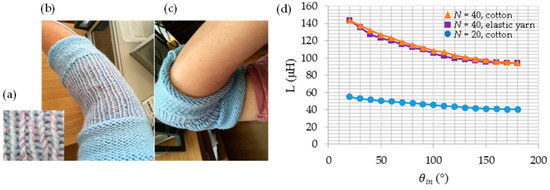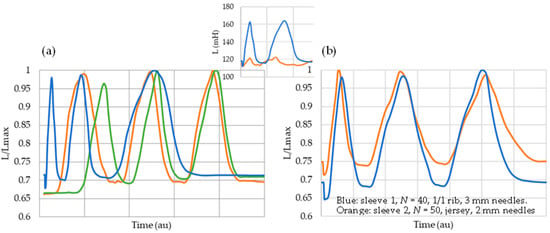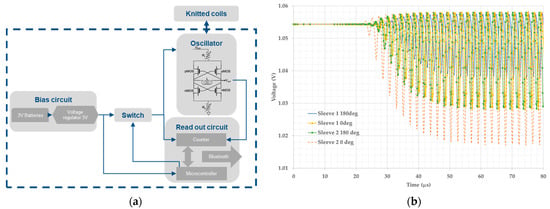Abstract
We present a highly sensitive wearable angular position sensor to measure joint movement. The sensor is a 3D helical coil knitted in the sleeve of a garment by circularly knitting thin insulated metal wire and yarn simultaneously. The sensing mechanism is based on the variation of the mutual inductance between windings. A 167 μH change is measured for knee movement from fully stretched to completely bent. A double cross coupled FET pair transforms the low-Q coils into a high-Q system giving a maximum frequency variation of 145 kHz for knee bending.
1. Introduction
Wearable sensors will play an important role in future health and wellbeing support approaches [1]. E-garments give patients more autonomy while clinicians can still access and evaluate the data remotely, when required. These sensors must be easy to wear and not hinder movement; read-out electronics must be low-power and compact; and the system easy to use and not require expert sensor placement. Wearables are candidates for deployment in rehabilitation, e.g., remote supervision of stroke victims’ exercises. They can be used in sports performance training and other applications where observations of quality and duration of movement are useful. Movement sensors come in different shapes and forms. Many are based on inertial sensors, including accelerometers, gyroscopes and magnetometers with small form factor and 3D movement registration possibilities [2]. Other sensor types are based on resistive [3] and inductive changes [4]. The advantage of these is their simplicity and direct relationship between measured parameter and angle of a joint. Inductive sensors have the added benefit for wearables that no additional layers are required for electrical isolation. We present an alternative implementation of an inductive sensor that is a knitted helical coil that forms part of a garment. These knitted coils are easily implemented at the elbow in a sleave or at the knee in a long sock. The inductor is circularly knitted, using yarn and thin insulated metal wire, forming a 3D helical coil [5]. Changes in the geometry of the coil changes its self-inductance which corresponds to the movement and the angle of a limb. This approach makes these garments indistinguishable from normal knitted clothes. In this work we demonstrate the feasibility of this implementation as a wearable ambulatory monitoring system.
2. Materials and Methods
Different sleeves were weft knitted by hand with circular needles using yarn and thin insulated metal wire simultaneously (Figure 1a). Sleeves were made in different diameters consistent with wrist, elbow and knee dimensions. The influence of the number of rows with metal (number of turns N), the type of metal wire (solid Cu magnet wire ~250 μm and Cu/Ag Litz wire ~150 μm diameter), the yarn and needle size and the knit style (jersey or 1/1 rib) were also investigated.

Figure 1.
(a) Coil stitches with Cu wire (red). (b) Sleave at large internal angle giving minimum inductance. (c) Sleave at smallest internal angle giving maximum inductance. (d) Self-inductance of 1/1 rib elbow sleaves as a function of angle.
The measurements were performed using a protractor system as in [6] and a Wayne Kerr 6500B precision component analyzer to measure the self-inductance, L, and series resistance, R. A small 50 mV ac voltage was applied at 200 kHz, well below the self-resonance of the coil. Movement was measured on a healthy test subject (Figure 1b,c).
The self-inductance of the knitted coil can be approximated by summing the loop inductances and the mutual inductance between different windings [7].
where s is the distance between the windings and Δs is its variation due to bending of the coil. The expression for the mutual inductance is ( are points on the coil):
This shows that the mutual inductance strongly depends on distance between windings (s1 − s2). A reduction in distance increases M sharply. Thus, bending the knitted coil will bring the windings at the inner angle of the limb closer together resulting in a sharp increase in L. When the limb is stretched out ( = 180°), L is minimum (Figure 1b) and fully bent ( ≈ 0°) L is maximum (Figure 1c). R does not change with bending.
3. Results and Discussion
The variation of L with inner angle for a sleave is given in Figure 1d. There is a steep response for small angles with the sensitivity decreasing for larger angles. This is as expected from Equations (1) and (2). The sensitivity decreases for lower N but its linearity increases. For a smaller region of 20° < < 120°, the variation of L with angle is nearly linear, given by the correlation coefficient R2. For N = 40 in 1/1 rib, Cu magnet wire and 3 mm needles, the wrist (not shown) sensitivity is 75 nH/° with R2 > 0.98, the elbow 353 nH/° with R2 > 0.97 and the knee (not shown) ~551 nH/°. The sensitivity increases with increasing sleeve diameter. Using elastic yarn did not change these findings (Figure 1d). Solid Cu magnet wire showed higher sensitivity than Cu/Ag Litz wire: 75 nH/° vs. 54 nH/°. The sensitivity of the knit was also slightly better than that of an inlaid coil that does not follow the horseshoe character of the stitches: 75 nH/° vs. 63 nH/°. The inlaid method has limited elasticity and is less suitable from a wearable’s point of view.
Dynamic measurements were carried out on three different healthy subjects (two females, one male), moving the elbow through all angles. Figure 2a shows the variation of the normalized inductance L/Lmax with movement as a function of time (time frame is ~6 s). There are two observations, whilst the absolute inductance for each subject is different because of different arm diameters, the normalized changes are nearly identical. At the start of the movement there are some memory effects in the knit (crinkling) that shift the minimum value of L. Once this initial shift has happened, no further changes occur until the crinkles are reset. The inset in Figure 2a gives the difference between changes in L when the sleave is worn on the elbow and when it is worn on the biceps whilst moving. The latter causes changes due to coil diameter changes in response to muscle movement. The change in inter-winding position is larger than that in diameter.

Figure 2.
Dynamic normalized response L/Lmax. (a) Elbow movement of three test subjects moving through the same angles at slightly different speeds. Inset: L in function of angle (blue) and diameter due to muscle movement (orange); (b) knee movement.
Figure 2b gives the dynamic measurement of the knee moving from full extension to fully bent for two different knit implementations. The crinkle-related memory effect is apparent at the start. It is slightly larger for the rib than the jersey because the jersey is firmer due to the smaller needle size used. The 1/1 rib implementation gives the largest variation of L for the same change in angle. This difference might be due to needle size rather than stitch type. Smaller needles give a firmer knit and allows less relative change between windings.
4. Electronic Readout
The block diagram of a possible readout system is given in Figure 3a. This is based on a high-Q oscillator as proposed in [8]. The time domain response of the oscillator is simulated using SPICE. The output of the oscillator for the two knee sleeve implementations in their extreme positions is given in Figure 3b.

Figure 3.
(a) Block diagram of an electronic readout. The oscillator has low capacitance FETs to boost its quality factor Q [8]. (b) Oscillator response for the knee sleeves in two extreme situations: fully stretched 180° and fully bent ~0°.
The high-Q oscillator ensures a readable output for the digital block even with the low-Q knitted coils. The low Q of the coils causes start up delays, but at τ < 100 μs it does not interfere with the operation of the digital readout block where a waiting time of 5 ms is implemented to settle the counter [8]. These delays are directly related to the coils’ Q. The performance parameters of coils and oscillator are given in Table 1. The maximum variation of L for knee sleeve 1 is ΔL = 104 μH and 167 μH for sleeve 2. This translates in a frequency variation of 144.7 kHz and 100.4 kHz, respectively. Although τ is largest for sleeve 1, this implementation is preferred over sleeve 2 from a readout point of view.

Table 1.
Performance parameters of the oscillator in the read-out circuit for knee sleeves. L inductance, R series resistance of the coil, fosc the oscillation frequency, |A| the amplitude and τ the start-up delay.
In conclusion, inductive 3D knitted coils integrated in sleeves of garments give unobtrusive sensors in knitted garments. Their high sensitivity is related to the fast increase in self-inductance with decreasing separation between windings. A maximum inductance variation of 167 μH was measured for the knee moving from full stretch to fully bent. This change can be measured in real time using a high-Q oscillator. The knitted coils are a feasible approach for real-time ambulatory monitoring using fully wearable everyday-looking clothes.
Author Contributions
Conceptualization, K.F.; methodology, K.F.; software, C.P.; validation, K.F. and C.P.; formal analysis, K.F.; investigation, K.F.; resources, K.F.; data curation, K.F. and C.P.; writing—original draft preparation, K.F.; writing—review and editing, K.F. and C.P.; visualization, K.F.; supervision, K.F.; project administration, K.F.; funding acquisition, NA. All authors have read and agreed to the published version of the manuscript.
Funding
No external funding was received for this work.
Institutional Review Board Statement
Ethical review and approval were waived for this study as the dataset is not related to clinical trials, is fully anonymized and consent was given.
Informed Consent Statement
Informed consent was obtained from all subjects involved in the study.
Data Availability Statement
Data can be requested from K.F.
Conflicts of Interest
The authors report no conflict of interest.
References
- Simpson, L.A.; Menon, C.; Hodgson, A.J.; Ben Mortenson, W.; Eng, J.J. Clinicians’ perceptions of a potential wearable device for capturing upper limb activity post-stroke: A qualitative focus group study. J. Neuroeng. Rehabil. 2021, 18, 135. [Google Scholar] [CrossRef]
- Zhou, H.; Stone, T.; Hu, H.; Harris, N. Use of multiple wearable inertial sensors in upper limb motion tracking. Med. Eng. Phys. 2008, 30, 123–133. [Google Scholar] [CrossRef]
- Isaia, C.; McMaster, S.A.; McNally, D. Study of Performance of Knitted Conductive Sleeves as Wearable Textile Strain Sensors for Joint Motion Tracking. In Proceedings of the 2020 42nd Annual International Conference of the IEEE Engineering in Medicine & Biology Society (EMBC), Montreal, QC, Canada, 20–24 July 2020; pp. 4555–4558. [Google Scholar]
- Bonroy, B.; Meijer, K.; Dunias, P.; Cuppens, K.; Gransier, R.; Vanrumste, B. Ambulatory monitoring of physical activity based on knee flexion/extension measured by inductive sensor technology. Int. Sch. Res. Not. 2013, 2013, 908452. [Google Scholar] [CrossRef]
- Fobelets, K.; Thielemans, K.; Mathivanan, A.; Papavassiliou, C. Characterization of knitted coils for e-textiles. IEEE Sens. J. 2019, 19, 7835–7840. [Google Scholar] [CrossRef]
- Li, M.; Torah, R.; Nunes-Matos, H.; Wei, Y.; Beeby, S.; Tudor, J.; Yang, K. Integration and Testing of a Three-Axis Accelerometer in a Woven E-Textile Sleeve for Wearable Movement Monitoring. Sensors 2020, 20, 5033. [Google Scholar] [CrossRef]
- Fobelets, K.; Sareen, K.S.; Thielemans, K. Magnetic coupling with 3D knitted helical coils. Sens. Actuators A Phys. 2021, 332, 113213. [Google Scholar] [CrossRef]
- Kiener, K.; Anand, A.; Fobelets, W.; Fobelets, K. Low Power Respiration Monitoring using Wearable 3D knitted Helical Coils. IEEE Sens. J. 2022, 22, 1374–1381. [Google Scholar] [CrossRef]
Publisher’s Note: MDPI stays neutral with regard to jurisdictional claims in published maps and institutional affiliations. |
© 2022 by the authors. Licensee MDPI, Basel, Switzerland. This article is an open access article distributed under the terms and conditions of the Creative Commons Attribution (CC BY) license (https://creativecommons.org/licenses/by/4.0/).